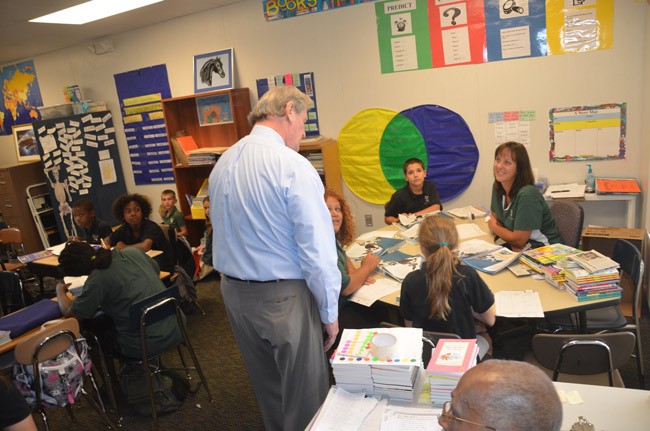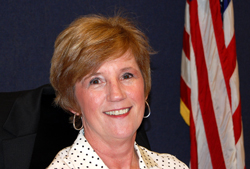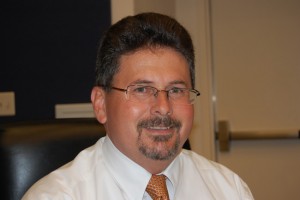
Note: The district is holding a meeting with Phoenix Academy parents at Wadsworth Elementary’s media center Wednesday, June 24, at 6 p.m., to explain the STEM Academy’s plan, and how Phoenix students may fit intro it.
![]()
In Greek mythology, the phoenix is a bird that periodically dies and is reborn out of its own ashes. In the Flagler County school district, Phoenix Academy has been a five-year experiment in alternative education, a small, separate, elementary school focused on science and technology. It’s enrollment of 75 at its zenith but just over 30 last year, has kept the school battling for its survival more often than not in its five years.
Tuesday evening, it appears that the Flagler County School Board, in a contentious 3-2 vote that reflected disapproval for the way the matter was handled, killed Phoenix.
It wasn’t an outright killing. The district is portraying it as a “transition” to a new setting, from Phoenix’s existing facility near the campus of Flagler Palm Coast High School to Wadsworth Elementary School starting this fall.
And if the district had planned the transition better, it might have portrayed it as what a phoenix does periodically: a rebirth under a different, very possibly stronger guise. But that’s not how it went as parents, students and faculty were to be last to know of the board’s decision, supportive though all five board members were about the ultimate goal of the transition.
So there were really two separate stories in the board’s 3-2 vote Tuesday evening, one of them very exciting, positive and forward-looking (like the sort of excitement that greeted the creation of Phoenix five years ago). The other is a story of poor communication, vagueness and hurry that had the two dissenting board members, including Colleen Conklin, who chairs the board, criticizing the lack of transparency in the process on behalf of affected teachers and parents.
“I don’t have any problem, I like what you put together,” board member Andy Dance, the other dissenter, told John Fanelli, the Wadsworth principal who developed the replacement and so-called Flagler County STEM Academy at Wadsworth, with teacher Martin Evans. “My only concern is the process. There’s 44 parents, this will be the first notice that there’s going to be significant action on Phoenix. We talked about it last time but there was no consensus to move forward. There was actually consensus for status quo,” or at least continuing the school for a year. “In three weeks, I don’t have a problem approving this, but I’m not going to approve this tonight and lay this suddenly on the parents without having their input in the process.”
Plenty of excitement about Wadsworth’s new program, but plenty of apprehension about the way the district got there.
“There’s a need for additional details in regards to budget, transportation, even the split schedule,” Conklin said. “Some of those details, when you’re making the decision to transition a program I think are appropriate.” Conklin stressed that she had nothing against the proposed academy at Wadsworth. “I think this is awesome. I think the concept of what you are presenting is valid. I think there are tremendous benefits to our district and to our students. I can see no reason not to support it. But in fairness, and in looking at process, I think you have to do it right. If a plan is going to be presented, and it’s going to be shared, there should be a budget presented along with what the program is specifically going to do and how we’re going to do it. Parents should have already been discussed with.”
For a time during the discussion, board member Trevor Tucker, too, said he was uneasy about the closing of Phoenix without parental involvement, though he was supportive of the new academy. But he ended up voting with Sue Dickinson and Janet McDonald to go ahead with the transition plan. McDonald said Phoenix “does not justify the inequitable use of resources for those 30 students, not only the programming, the facility and the chauffeuring. Talking about fairness, I think we need to use our resources that are equitably to serve.”
“I understand the concerns. I understand you all wanting to wait until our next meeting, which is three weeks from tonight,” Dickinson said. But she was supportive of Fanelli’s and Evans’s hope to get going recruiting. “Are there going to be some that aren’t going to like it? Yes, there are. Do we ask every students, parents, in Flagler County, what they want for their child? No. We don’t ask every parent. We don’t go to every parent and say what do you want for your child and what do you want for your child. We offer the programs, and the parents put the children.” She concluded that “this program can be sold to these parents without any problem.”

STEM is the acronym for science, technology, engineering and math.
The district is holding a meeting with Phoenix parents at Wadsworth Elementary’s media center Wednesday, June 24, at 6 p.m., to explain the STEM Academy’s plan, but also to get a sense from Phoenix parents what the future of Phoenix might be. Orndorff said it’s still not clear what would happen if, say, 15 parents decide to stick with Phoenix as it is. We’ll have some answers after we meet with parents and communicate some options out with them,” he said.
That gray area left board members wrestling with the status matter, with some members eeing the creation of Wadsworth academy as the inevitable end of Phoenix.
“It’s silly to separate them because you’re effectively killing Phoenix,” Dance said Tuesday evening. Dickinson disagreed. Dance continued: “You are, because you’re targeting the same students and you’re adding two teachers and you’re going to have a smaller Phoenix with additional two teachers, so our operating expenses are going to go up to maintain both facilities. You should look at them both together and either wait three weeks, and give the parents of Phoenix an opportunity to come before us and have a combined motion to transfer and reboot Phoenix into Wadsworth. I approve of what they’re doing, but in theory, what we’re doing is going to end up coming back and closing Phoenix anyway, and there’s still questions about funding, there’s still questions about transportation, because Phoenix students are getting transported. There’s still a few details I’d like to see worked out.”
Fanelli and Evans plan to meet with every one of the Phoenix parents and students to discuss the new program and try to recruit them into it. As of today, Phoenix is still recruiting students for this fall.
The board’s discussion of the process overshadowed the presentation by Fanelli and Evans about the new academy. But that presentation is central to the way the new school-within-a-school will work, and what it will offer, just as it will be central to Wadsworth’s recruiting pitch to the 44 students it hopes to enroll.
“We’re looking to create a program where we teach kids information but then we give them opportunities to apply that information to real world applications,” Fanelli said. “And yes, that’s something that we’d want to do in all our classes every day, but this is a program that would specialize on taking that to the next level. The kids would sit down, they would learn math, and then they would have a practical application for that math. ‘This is why you need to learn this, and this is what you’re going to do with it.’ So we’re really excited about this.”
When Famelli and his colleagues first started talking about the program, he said, it sounded similar to what was going on at Phoenix, making it a good fit for those Phoenix students. “Although they would be part of our school and they would benefit from all of the amenities of a large school—guidance counselors, media specialists, awards assemblies, afterschool programs—they would still be their own separate” entity. “We think that a lot of the students that are at Phoenix currently might benefit from this program.”
Wadsworth’s flagship program is the arts, but it’s incorporated into a larger program that plays on the STEM acronym. Instead it’s STEAM, with the added A incorporating the arts.

Wadsworth has empty classrooms and needs to fill them, not least because each student commands several thousand dollars in state aid, which helps pay for the school’s staff. “This will not be technically an extra program, it still is going to fit in with the staffing program that’s right now in place. So we’re not talking about adding a whole bunch of teachers,” Evans said.
The focus of the new academy will be sixth grade this coming year, with spots available for fifth grade. The school’s aim is to open the program, eventually to fourth through sixth grade, with an eye on adding 7th and 8th graders down the line. This coming year, however, some 7th graders will be involved in the program as “interns,” after they get out of class at nearby Buddy Taylor Middle School. Further on, those 7th and 8th graders will be coming online classes with the STEM Academy.
The 44 students in the academy will have a choice of attending a morning session or a later session, one starting at 7:15 a.m., the other at 9 a.m. Students would be bused on middle school buses for the early session. If students are outside the Wadsworth zone, parents would have to provide it. Each session would be stretching six hours total, or they can attend both, with a guaranteed six hours of instructional time. The staff would consist of two teachers (one of whom would direct the program) and one para-professional. One of the teachers will be on call any time between 5 and 7 p.m. for texting, emailing or talking. Parents will be required to participate through volunteering, putting in at least eight hours over the course of a year. “Community professionals” will be asked to participate as well.
When asked by Tucker how much the new program will cost, compared to Phoenix, Evans surmised that it would be a “positive” difference. “Of course the one thing I did discuss with Mr. Oliva is we would need a boost to get started,” Evans said, “for materials. That was the only fiscal impact initially.” The district wants iPads and laptops, including 3D design and 3D printing. “I want to expand that. Right now we’re able to do it with a couple of students. I want to do it with classes of students.”
The agenda item did call for the board’s approval to “transition” Phoenix into the STEM Academy, but it was not clearly stated as such on the agenda, except in the fine print. The board itself had been in discussion about the future of Phoenix, talking about it two weeks ago. The discussion was split between members who wanted to keep it where it is and those willing to shift it.
In the end, the new STEM academy got the go ahead, but on a note more sour than either the board or the academy’s presenters had been hoping for: it is procedural missteps of that kind that typically come back to haunt the board when parents or others seize on the memory to be critical of the board’s openness and inclusiveness on unrelated matters, even as the board works hard to subscribe to those two principles.
“This whole process has been handled very poorly,” Conklin said at the end of the discussion. “The lack of communication with the teachers, the lack of communication with parents, we have been discussing this item for two months and it was asked to communicate these issues with parents, faculty and staff at the location. So I’m very disappointed in how this process is handled. But I have no doubt that whatever will end up transitioning those students, it will benefit them.”
![]()
Flagler County STEM Academy at Wadsworth (2015)





























Richard says
Amazing, this is history, probably the first time the board has ever had a real debate and not a unanimous vote. I’m not certain they know what the word transparency means.
a tasty bacon sidedish says
And here’s the problem I’ve experienced with some STEM students.
The k-12 system as currently implemented doesn’t give students the chance to develop the character needed to deal with failure (see for example matanzas and its 10 point F). As a consequence, when they hit higher ed and experience their first difficult class they have a tendency to collapse and either quickly develop the fortitude to get it together or they drop out. k-12 doesn’t care because they’ve passed the buck to higher ed and everything looks good on paper, but then higher ed ends up with retention problems. As a consequence, higher ed administration pushes STEM-related departments to lower standards or they’ll start laying off people because the retention is down. If it’s a community college or state college, then the interest in student success only extends to the graduation date or the point of transfer, and to paraphrase things that I have heard, “go easy on your students because let’s be serious they’ll never use math/science/etc after your class.”
That’s what happens when you micromanage the educational system under the guise of the free market, and attempt to apply some arbitrary standards through standardized testing. If you tie someone’s pay to their student’s performance on a standardized test, then you’ll have students that perform well on a standardized test and that’s about it.
nomad says
Whatever the school district decides to do one thing is for sure, it needs to step up its math program.The excuse or misconception that poverty is the reason for why poor kids in America cannot learn isn’t holding up to scrutiny.
See: America Urgently Needs More Immigrants
“If the United States wants to go on as a world power, it must strengthen its brain power against China. But this will only work if it can entice highly qualified immigrants to come to the country.[…] According to the 2012 Program for International Student Assessment, 51 percent of all American children performed deficiently, insufficiently, or still worse in math.
http://watchingamerica.com/WA/2015/06/16/america-urgently-needs-more-immigrants/
a tasty bacon sidedish says
Wrong about the poverty thing, school systems get a large amount of money from property taxes. In poor communities property taxes are low, meaning that operational funds are low, so there’s less dollar per student available. This translates to fewer teachers and poorly equipped facilities, and when combined with the home life that many poor homes have you end up with students that just aren’t mentally or educationally prepared for higher ed.
If you want to improve america’s position with respect to the rest of the world, you need to a) stop tying operational budgets to property taxes, b) get rid of salaries for school board members so they aren’t politicized positions, c) implement methods in the classroom that have solid, statistically demonstrated success instead of feelgood “I am a visual learner” nonsense, d) keep the legislature out of the classroom, i.e. common core and no child left behind, e) get rid of the education degree as a requirement to teach and instead require at least a bachelors in the field they want to teach in, f) actually pay teachers a good salary, g) get rid of performance pay for teachers, h) allow students to experience failure in the classroom, i) reduce the non-teaching duties of teachers, allowing them to actually teach, j) get rid of fcat-style benchmarks, and so on. It’ll never happen, k-12 education is top heavy with people that need to be somewhere other than education.
Kiley says
I am a student in the Wadsworth STEM Academy and I don’t really like this idea because STEM Academy is soppose to be for student that are specially selected after interviewing and have to have a 3 or higher on fsa and I feel like this is taking away from the STEM Acamy and it won’t be as much of a reward and also would they do after school lab too